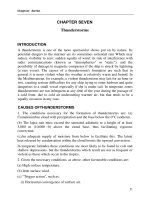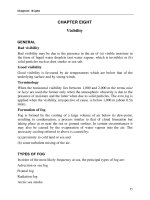BÀI GIẢNG KHÍ TƯỢNG THỰC HÀNH CHƯƠNG 2
Bạn đang xem bản rút gọn của tài liệu. Xem và tải ngay bản đầy đủ của tài liệu tại đây (106.19 KB, 3 trang )
CHAPTER 2 Observation of Atmospheric Pressure
CHAPTER 2 Observation of Atmospheric Pressure
2.1 Definition and unit
Hecto-pascal (hPa) should be used as the unit of the atmospheric pressure. There are some
other units for the atmospheric pressure, such as mb, mmHg, inchHg, etc. Note the following
relations:
1 hPa = 100 Pa = 1 mb
1 mmHg = 1.33322 hPa
1 inchHg = 33.8639
hPa
The detailed list of conversion from mmHg to hPa, is shown in the "Guide to Ships' Weather
Reports" separately issued by the JMA.
2.2 Measuring instruments and their installing conditions
The marine aneroid barometer is generally used for the measurement of the atmospheric
pressure. The marine aneroid barograph is used to record barometric tendencies and amount of
change. The resonator digital barometer as described later is also adopted to record the
atmospheric pressure, barometric tendencies and amount of change.
In installing these instruments, the following should be reminded:
1) To avoid exposure to the direct sunshine.
2) To install instruments at a place with small temperature change.
3) To reduce the effect of vibrations and shocks caused by the engine and/ or ocean waves,
cushion material such as sponge rubber had better be put on lateral and/ or down sides of
the instruments.
4) The marine aneroid barometer is usually installed horizontally. If you have to put it on a
vertical wall, its indicated value should not differ by more than 0.5 hPa from that of
normal installation.
2.3 Aneroid barometer
The aneroid barometer is affected by uncertainties due to variations in the elastic properties
of the spring and capsule and due to wear in the mechanical linkages. The precision marine
aneroid barometer developed with high quality (see Fig. 2.1) is recommended for weather
observation by ships.
Before you read the atmospheric pressure, tap the glass face with your finger so that the
needle vibrates slightly. Then fix one of your eyes right above the needle and read the scale. If you
find the image of your eye reflected in the glass exactly at the same horizontal position with the
needle, your eye is correctly located for observation. If your barometer has a mirror
6
CHAPTER 2
Observation of Atmospheric Pressure
on the scale plate, you can easily adjust your eye position.
When the ocean wave is high, your ship suffers large rolling and pitching, resulting in its
displacement and vertical acceleration so that the needle of the barometer shows horizontal
oscillations. In this case, read the maximum and the minimum values of the scale for several
reading samples. The average value of these data should be recorded as the observed value.
The observation of the atmospheric pressure should be made exactly on the observation
hour and the pressure should be recorded up to the order of 1/10 hPa.
2.4 Electronic barometer
There are two main types of electronic barometers which are used for weather
observations. One is a resonator digital barometer and the other is an electric capacitance
barometer. The former one works on a principle that a frequency of the sensor varies with
atmospheric pressure. The latter works on a principle that an electric capacitance varies with
atmospheric pressure.
The electronic barometer does not indicate the instantaneous value of the atmospheric
pressure but rather the averaged value over a certain short period. You can therefore make
accurate observations even on board with rolling and pitching.
You can also avoid observation errors arising from your personal tendency in reading the
instrument, because this instrument displays a digitized value and free from parallax.
2.5 Correction for instrumental error
The indicated value of a barometer is mostly different from the true value to some extent.
This intrinsic difference is called as "instrumental error" and should be corrected to get the
station value (see 2.6) of the atmospheric pressure.
The barometer should be checked every 6
months by PMOs to maintain the accuracy (see Ch.12).
2.6 Correction to sea level
The atmospheric pressure at mean sea level is to be reported and can be derived from the
observed value of the instrument installed at a height above mean sea level (referred to as
station pressure). This derivation is called "correction to mean sea level". The correction
depends not only on the height where the instrument is installed but also on station pressure *
and temperature. See "Guide to Ships' Weather Reports" for the detailed table to make
correction.
The height of the barometer above mean sea level should be checked when your ship is
fully loaded or unloaded. If the draught level of your ship varies within + or - 1 m around the
averag~ level, you can always apply the height of the barometer above the average draught
level to the correction.
If, for example, the station pressure is 997.4 hPa, the level height of the barometer above
mean sea level 6 m and the temperature 13°C, the correction value will be 0.7 hPa according to
the table mentioned above. And the corrected value is obtained as follows:
* Station pressure is defined as the pressure at barometer level.
7
CHAPTER 2 Observation of Atmospheric Pressure
997.4
(station pressure)
+
0.7
(correction)
=
998.1 hPa
(pressure at mean sea level)
2.7 Barograph
A barograph is used to check observed values of pressure and to record barometric
tendencies and amount of change. Fig.2.2 shows an aneroid barograph, one of the several
available types of barographs. The barograph paper which records the continuous record of
pressure is called barogram. Barograms must be renewed at a certain interval (from 1 day to 7
days, depending on the instrument). The barograph is recommended to be installed because it
can show you whether a high, a low, a trough or a ridge is approaching or getting away. You
could then presume the tendency whether the weather is recovering or getting worse.
As for where and how to install the barograph, refer to comments noted in 2.2 for the
barometer.









